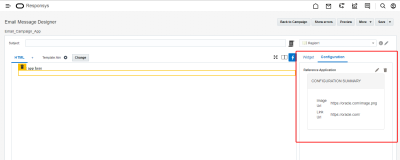Summary URL endpoint
This endpoint is called after the service configuration window is closed, and the user is taken back to the Email Message Designer.
Service URL
<app-base-url><service-summary-url>
These URLs are registered with AMS when creating a service.
Request Method
POST
Request Header
Authorization: Bearer <JWT>
OMC-ID: <instanceId>
Content-Type=application/json
JWT claims
In the case where it is the product making the request to the App, the key and value pairs bear the following meanings:
| Key | Value Definition | Context |
|---|---|---|
aud
|
The audience of the token. | The service instance UUID. |
iss
|
The issuer of the token. | The product UUID. |
exp
|
The date and time the token will expire, expressed as a Unix timestamp. Must be after the current date/time. | Set to 60 seconds after the JWT was created. |
iat
|
The date and time the JWT was issued, expressed as a Unix timestamp. | Set to the current time. |
o.a.p.ctenantId
|
The tenant Id. | Set to the id of the tenant as identified by the product. |
This endpoint is called after the service configuration window is closed, and the user is taken back to the Email Message Designer. Responsys calls the Summary URL endpoint to display the configured app details in the Email Message Designer.
When this endpoint is called, the app must respond with an HTML configuration page to be embedded within an iframe in the product.
To display a service's configuration details, the app can retrieve the service's instance UUID. The service's instance UUID can be fetched with the getMetadata call to AMS.
The postMessage resembles:
{
amsAction: 'metadata'
}
The metadata section of the response will include the Service Instance UUID as the instanceId:
"metadata": {
"instanceId": "b243e185-33fd-4599-a25a-8c4a127a6ac5"
}
